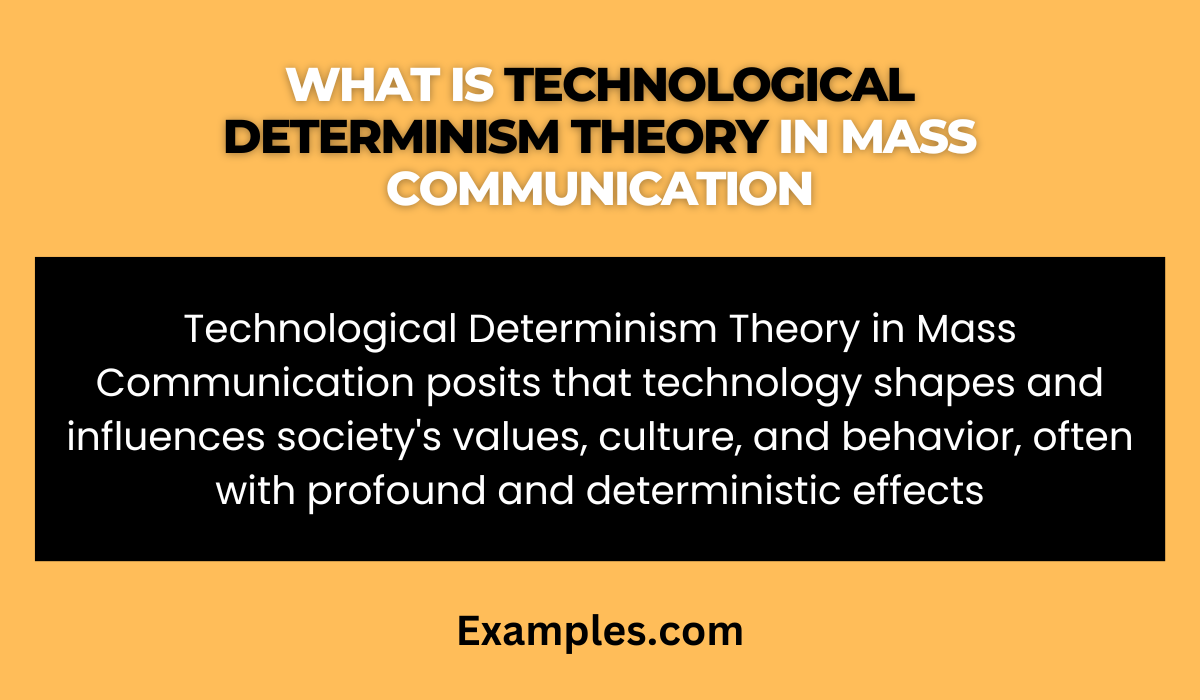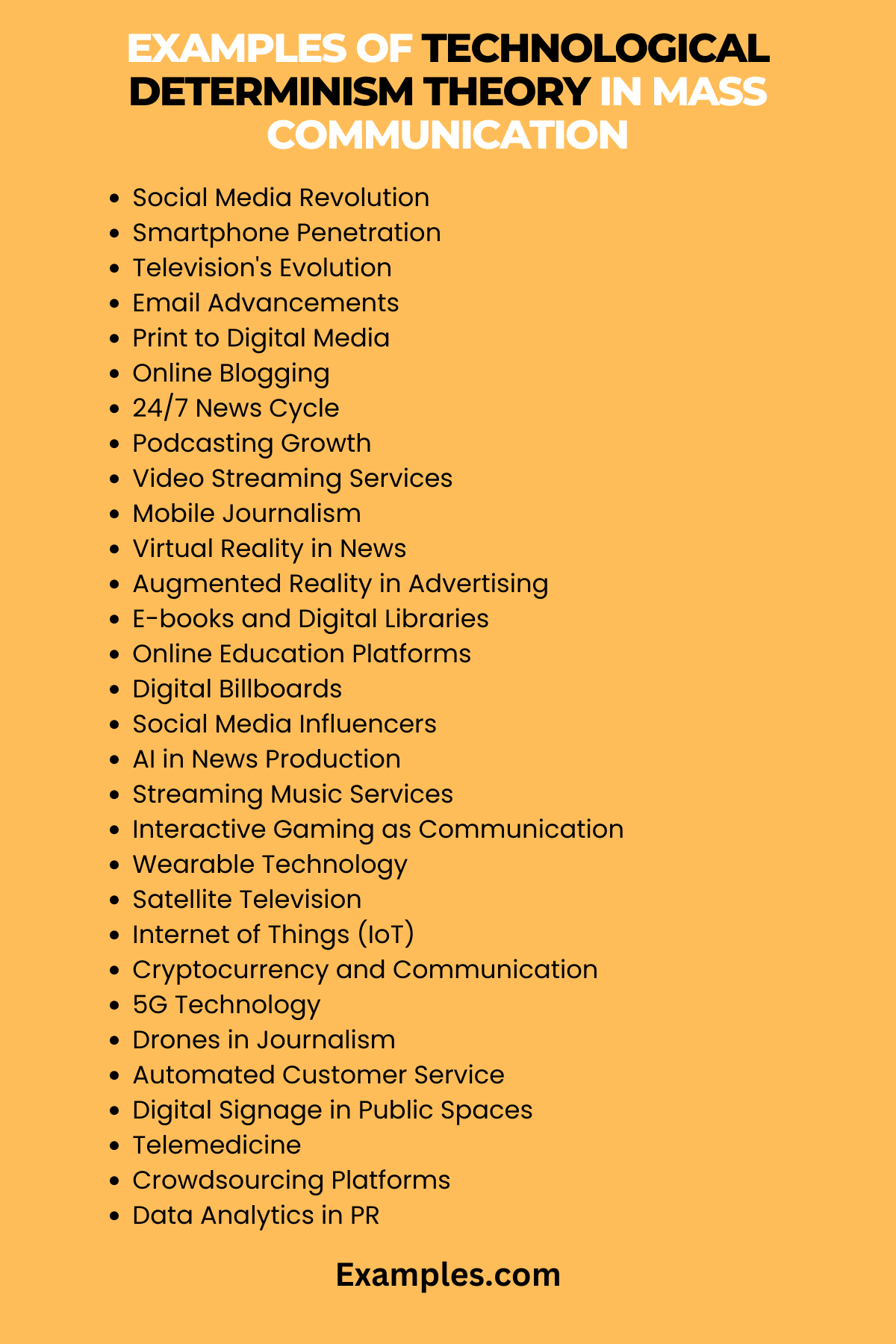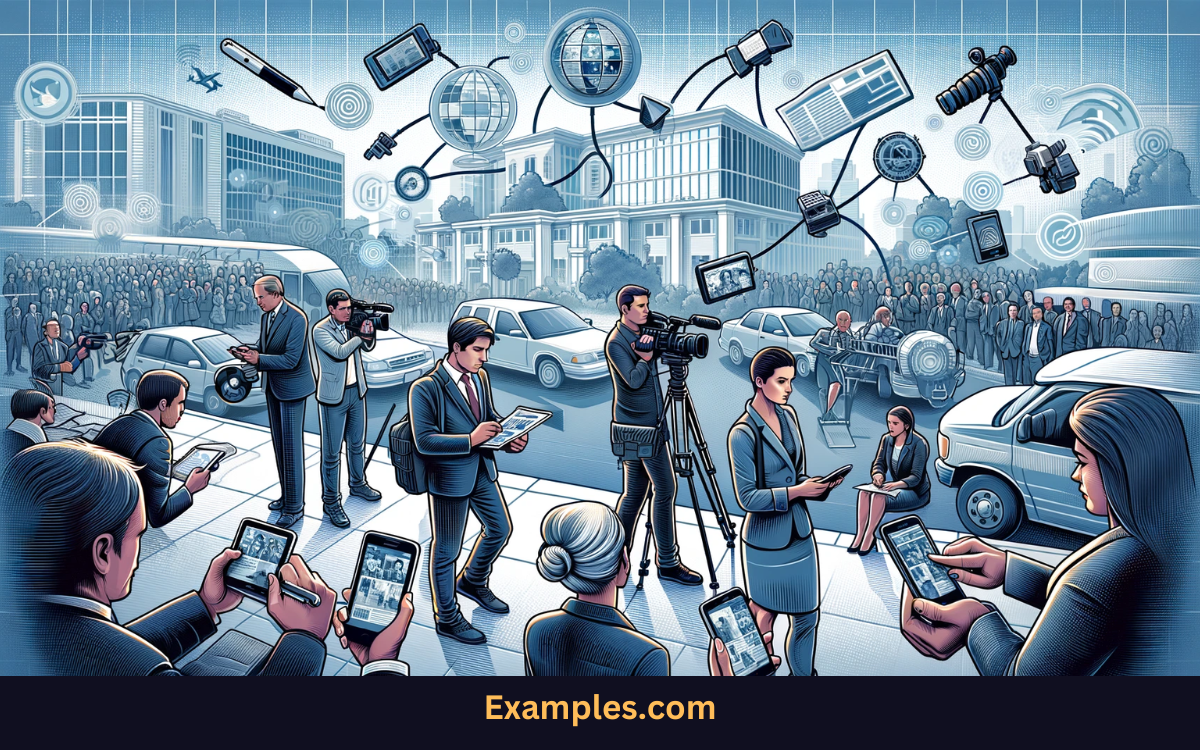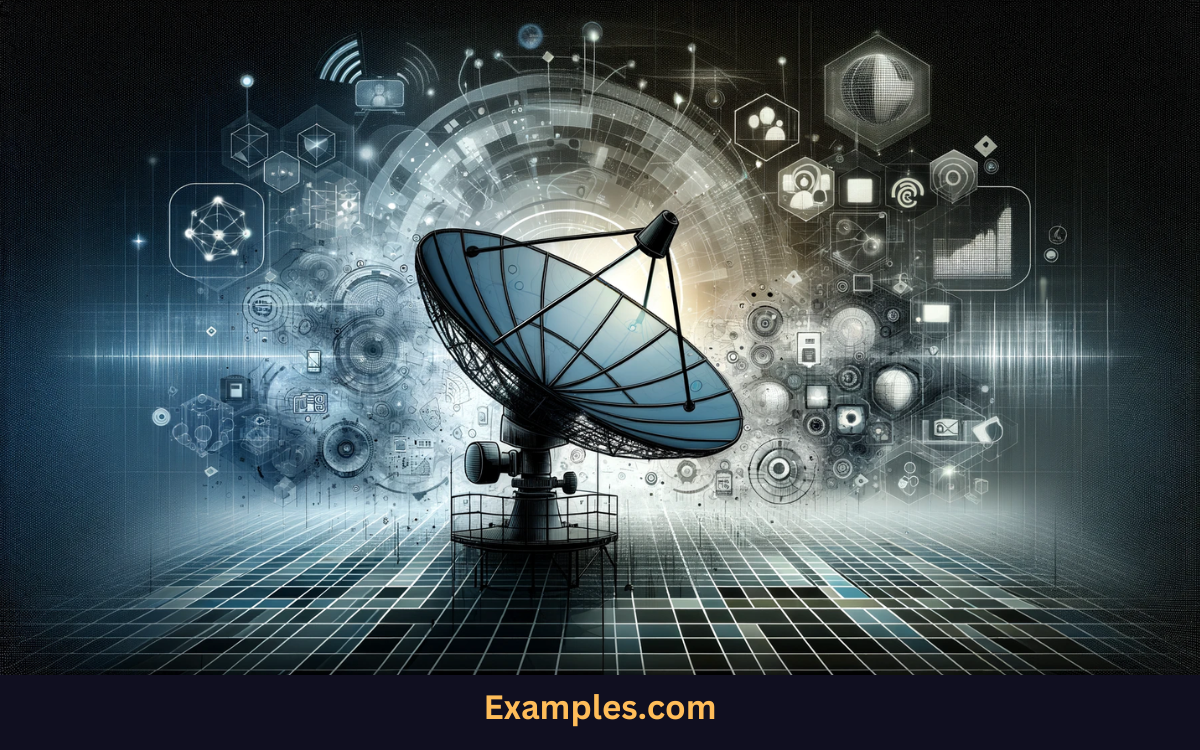29+ Technological Determinism Theory in Mass Communication Examples
Exploring the intricate world of Technological Determinism Theory in Mass Communication unveils a fascinating intersection where technology shapes societal communication. This theory posits that technological advancements significantly influence the dynamics of mass communication scenarios/situations, altering how messages are disseminated and received. Understanding this theory is crucial in an era where mass communication examples in journalism and other media realms constantly evolve. This comprehensive guide delves into how technological determinism molds mass communication, impacting everything from social media strategies to traditional broadcasting methods.
What is Technological Determinism Theory in Mass Communication
Technological Determinism Theory in Mass Communication is a concept suggesting that technological developments shape societal and cultural changes. In the context of mass communication, this theory posits that the development and adoption of new media technologies play a pivotal role in influencing how information is disseminated and how it impacts the audience. The core premise is that changes in technology, more than anything else, dictate how communication occurs and evolves.

History of Technological Determinism Theory in Mass Communication
The roots of Technological Determinism Theory in mass communication can be traced back to the early 20th century. Scholars like Marshall McLuhan, who famously said, “The medium is the message,” contributed significantly to this theory. The evolution of mass media, from print to radio, television, and now digital platforms, demonstrates how each technological advancement reshaped communication strategies, content delivery, and audience interaction.
What is the Best Example of Technological Determinism Theory in Mass Communication
One of the best examples of Technological Determinism Theory in mass communication is the transition from traditional print media to digital media. This shift has profoundly changed how news is reported and consumed. The rise of digital platforms, such as social media and blogs, has democratized information dissemination, allowing not just professional journalists but also ordinary citizens to play a role in news creation and sharing. This example illustrates how technology not only changes the way we communicate but also influences the structure and nature of the communication industry itself.
In this comprehensive guide, we’ve explored the essence, historical context, and a prime example of Technological Determinism Theory in mass communication, illustrating its significant impact on how we interact with media in our daily lives.

30 Examples of Technological Determinism Theory in Mass Communication
Technological Determinism Theory posits that technology development drives societal and cultural changes. This theory is crucial in understanding the profound impact of technology on mass communication. Here are 30 examples, each illustrating how technological advancements have shaped mass communication practices and concepts.

- Social Media Revolution: The rise of platforms like Facebook and Twitter transformed how news is disseminated and consumed, exemplifying social media mass communication.
- Smartphone Penetration: The widespread use of smartphones has democratized access to information, altering the landscape of mass personal communication.
- Television’s Evolution: From black-and-white to smart TVs, television technology has continually reshaped broadcasting and audience engagement.
- Email Advancements: The development of email revolutionized business and personal communication, enabling instantaneous global messaging.
- Print to Digital Media: The shift from print to digital media highlights how technology alters content consumption and distribution.
- Online Blogging: The emergence of blogging platforms has provided individuals with new avenues for mass communication and expression.
- 24/7 News Cycle: Accelerated by digital advancements, the constant news cycle has transformed how the public receives and processes information.
- Podcasting Growth: The rise of podcasting as a mass communication medium illustrates technology’s role in creating new informational and entertainment platforms.
- Video Streaming Services: Platforms like Netflix and Hulu have revolutionized media consumption, impacting broadcasting and television industries.
- Mobile Journalism: Smartphones enable journalists to report from anywhere, changing the dynamics of journalism mass communication.

- Virtual Reality in News: VR technology in journalism offers immersive storytelling experiences, altering audience engagement.
- Augmented Reality in Advertising: AR technology has transformed traditional advertising methods, offering interactive and engaging consumer experiences.
- E-books and Digital Libraries: The transition from physical to digital books has impacted publishing and information access.
- Online Education Platforms: The emergence of e-learning platforms has redefined educational communication.
- Digital Billboards: The evolution from static to digital billboards has transformed outdoor advertising strategies.
- Social Media Influencers: Influencers represent a new breed of mass communicators, born from social media platforms.
- AI in News Production: Artificial Intelligence in journalism, like automated reporting, exemplifies technological impacts on mass communication jobs/careers.
- Streaming Music Services: Services like Spotify have changed how music is distributed and consumed, influencing the music industry’s communication strategies.
- Interactive Gaming as Communication: Online gaming platforms have become significant channels for social interaction and community building.
- Wearable Technology: Devices like smartwatches have introduced new ways of personal and mass communication.
- Satellite Television: Satellite technology expanded TV’s reach, bringing global content to diverse audiences.

- Internet of Things (IoT): IoT’s interconnected devices offer innovative communication methods in everyday life.
- Cryptocurrency and Communication: The rise of digital currencies has influenced financial communication methods.
- 5G Technology: The introduction of 5G is set to revolutionize mobile communication with increased speed and connectivity.
- Drones in Journalism: Drones have become essential tools in modern journalism for aerial reporting and photography.
- Automated Customer Service: Chatbots and AI customer service represent technological shifts in corporate communication.
- Digital Signage in Public Spaces: Enhances mass communication in urban environments through dynamic and interactive displays.
- Telemedicine: Revolutionizes healthcare communication, bridging gaps between patients and healthcare providers.
- Crowdsourcing Platforms: These platforms exemplify how technology has democratized content creation and dissemination.
- Data Analytics in PR: Advanced analytics tools have transformed public relations mass communication strategies by enabling targeted and effective messaging.
Role of Technological Determinism Theory in Mass Communication
Technological Determinism Theory is a critical framework in understanding the impact of technology on mass communication. It posits that technological advancements drive social and cultural changes, profoundly influencing how mass communication evolves. Here are key points that highlight its role:
- Shaping Media Landscape: Technological determinism theory suggests that new technologies shape the media landscape. For example, the rise of the internet transformed traditional media, paving the way for social media Mass Communication and blog Mass Communication.
- Influencing Content and Format: The theory also underscores how technology influences the content and format of communication. Television and radio, for instance, brought forth different storytelling techniques compared to print media.
- Determining Access and Reach: Technological advancements dictate the reach and accessibility of mass communication. The widespread availability of smartphones and the internet has democratized information access, impacting how news and information are disseminated.
- Changing Audience Engagement: With advancements in technology, the ways in which audiences engage with media have evolved. Interactive platforms and social media have created a two-way communication channel, challenging traditional, one-way mass communication models.
Importance of Technological Determinism Theory in Mass Communication
Understanding the importance of this theory in mass communication involves recognizing its impact on various aspects:
- Guiding Industry Practices: This theory helps media professionals understand how technological changes can dictate industry trends. This understanding is crucial for Mass Communication Jobs/Careers, where staying abreast of technological trends is key.
- Influencing Public Perception: Technological determinism theory plays a significant role in shaping public perception. For instance, the shift from print to digital media has changed how audiences perceive news credibility.
- Educational Implications: In academic settings, this theory is fundamental in teaching the evolution of media. It is particularly relevant in courses discussing Mass Communication Examples in School.
- Policy Making: Understanding this theory assists policymakers in crafting regulations that are responsive to the dynamic nature of technology-driven communication.
How to Use Technological Determinism Theory in Mass Communication
Applying technological determinism theory in mass communication involves several strategies:
- Adapting to Technological Changes: Media professionals should continuously adapt their strategies to align with emerging technologies. This could involve embracing new platforms like Social media Mass Communication or Email Mass Communication.
- Predictive Analysis: Use the theory to anticipate future trends in communication technology. This foresight can be crucial in strategizing for future media landscapes.
- Enhancing Educational Curricula: Incorporate this theory in mass communication courses to provide students with a comprehensive understanding of the relationship between technology and media.
- Informing Content Creation: Understanding how technology shapes audience preferences can guide content creation, ensuring it resonates with the target audience.
In the realm of Mass Communication, Technological Determinism Theory suggests that technology shapes societal structures and cultural values. This conclusion highlights the significant influence of technology in altering communication patterns, behaviors, and societal norms. It emphasizes the pivotal role of emerging technologies in redefining the landscape of Mass Communication, influencing jobs, content creation, and the consumption of media.



